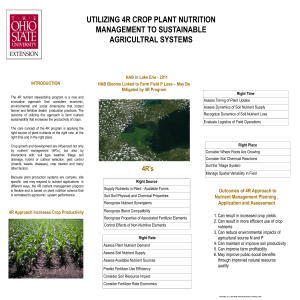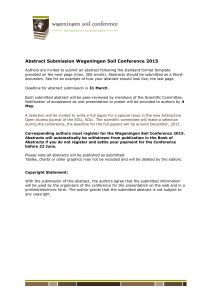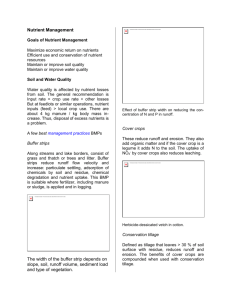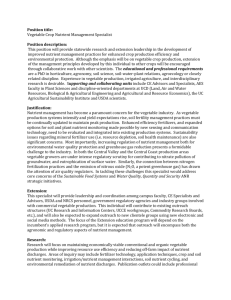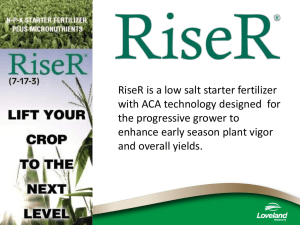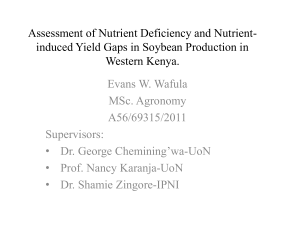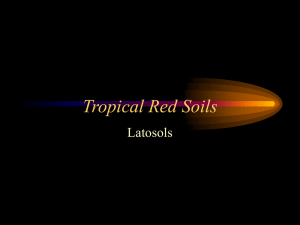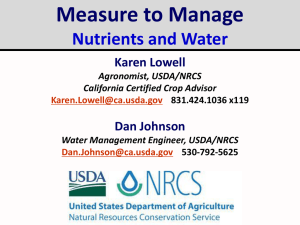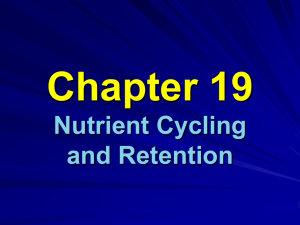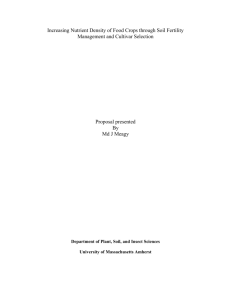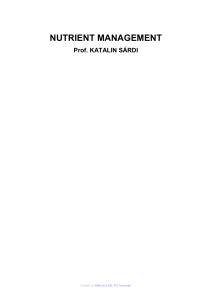4R Nutrient Stewardship Presentation for Cattleman
advertisement
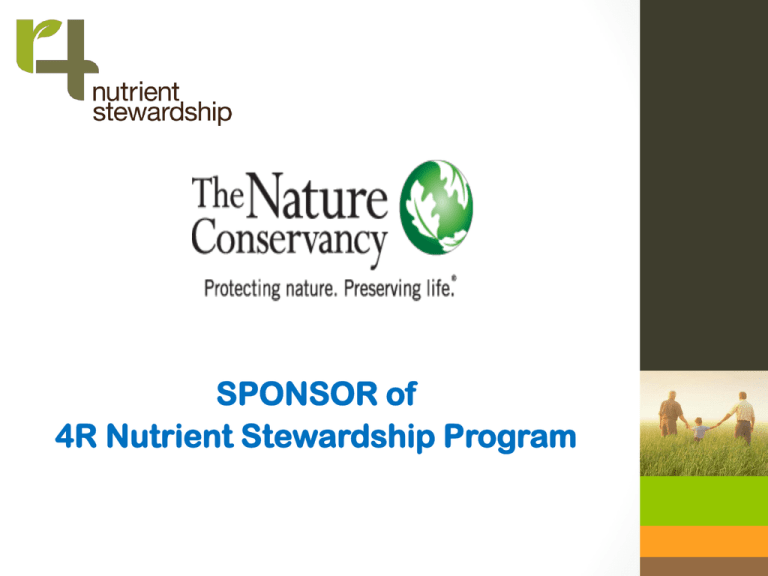
SPONSOR of 4R Nutrient Stewardship Program The Nature Conservancy Teaming with the Florida agriculture industry to increase farmer profitability and reduce nutrient loss and run off to the State’s waters Agriculture is Being Challenged • Population growth will continue to increase demands on production efficiency • Increased scrutiny related to land and resource management Essential Goal of Agriculture • Simultaneously improve productivity & efficiency • Increasing societal demands • Global financial stress • Growing concerns on impact to air and water quality • Efficiency without productivity • Increases pressure to use marginal lands • Productivity without efficiency • Squanders resources & increases environmental impact 4R Nutrient Stewardship • Improve agricultural production while contributing to social well being and minimizing environmental impacts (benefits water and air quality) • 4R represents the use of fertilizer Best Management Practices to ensure: • • • • the right source at the right rate at the right time in the right place 4R’s • The concept is simple – • apply the right source of nutrient • at the right rate • at the right time and • in the right place • But the implementation is knowledgeintensive and site specific. Framework for management systems and education based on basic universal scientific principles 1. Supply in plant available forms 2. Suit soil properties 3. Recognize synergisms among elements 4. Blend compatibility 1. Assess timing of crop uptake 2. Assess dynamics of soil nutrient supply 3. Recognize timing of weather factors 4. Evaluate logistics of operations 1. Appropriately assess soil nutrient supply 2. Assess all available indigenous nutrient sources 3. Assess plant demand 4. Predict fertilizer use efficiency 1. Recognize root-soil dynamics 2. Manage spatial variability 3. Fit needs of tillage system 4. Limit potential off-field transport Why Soil Sample Florida: 42 million acres Agriculture: 9 million acres Bahiagrass: 2 million acres Florida Department of Agriculture and Consumer Services Soil Testing: 3-Step Process 1. Soil Sampling: a) Collection of Soil Samples b) Handling and Submitting 2. Laboratory Extraction and Analysis: a) Sample Preparation b) Extraction and Measurement of Plant Nutrients in the Soil 3. Interpretation and Fertilizer Recommendation: Making sense of the results to make reasonable nutrient (fertilizer) application recommendations for a specific crop Collection of Soil Sample 40-acre field 40-acre field X X X X X X X X 30 ft 30 ft X Field Ditch X X X X 30 ft X X X X X X X 100 ft 100 ft Road Weakest link of soil testing process Remember that a very small area is sampled High field variability 15 - 20 core samples collected per 40-acre field Sample areas that are significantly different separately Soil Testing • Soil sample that you take is sent to the UF/IFAS Soil & Water Quality Lab in Gainesville or reputable lab. • • • • Inexpensive Determines pH Accurate Analysis Recommendation for nutrients (fertilizer) given based upon the forage desired. TAKE SOIL SAMPLE ATLEAST A MONTH BEFORE YOU FERTILIZE IN CASE YOU NEED TO ADJUST pH. LEAF TISSUE SAMPLE TO SEE PLANT NEEDS. Example Fertilizer BMPs • Source • Select appropriate fertilizer nutrient source • Consider fertilizer form for soil type and conditions • Consider fertilizer form for application time • Consider enhanced efficiency fertilizers • Rate • Grid or zone soil testing for rates • Nutrient budgeting to plan management and application • Address spatial variability with variable rate application technology • Use in-season methods for in season rate decisions Example Fertilizer BMPs • Time • Follow recommended times for nutrient applications • When necessary utilize enhanced efficiency fertilizers for controlled nutrient release and urease or nitrification inhibition • Utilize split applications to improve crop nutrient uptake. • Place • Utilize application methods that limit nutrient losses • Incorporate fertilizers • Adjust applications to avoid unnecessary applications to non-crop areas • Couple applications with appropriate soil conservation practices • Utilize controlled drain management in the fields. 4R’s are being added to the BMP Manuals • Minimize the pollutants that leave your property by controlling the types of materials used on your operation. Nutrient-related pollutant discharges can come from excess use or inefficient placement or timing of commercial fertilizer, manure, and/or bio solids. Managing nutrients carefully is critical to protecting water quality. An increasingly accepted and successful nutrient stewardship framework called the 4Rs captures all the elements of appropriate nutrient management. 4Rs are being added to the BMP Manuals • The principles of the 4Rs program are: • Right Source – Ensure a balanced supply of essential nutrients, considering both naturally available sources and the characteristics of specific products, in plant available forms; • Right Rate – Assess and make decisions based on soil nutrient supply and plant demand; • Right Time – Assess and make decisions based on the dynamics of crop uptake, soil supply, nutrient loss risks, and field operation logistics; and • Right Place – Address root-soil dynamics and nutrient movement, and manage spatial variability within the field to meet site-specific crop needs and limit potential losses from the field. It is sound science in action. Successful use of the 4Rs is dependent on proper crop and water management. For more information, go to: www.nutrientstewardship.com. Best Management Practices • BMPs are the individual or combined practices determined through research, field testing and expert review to be the most effective and practicable means for improving water quality, taking into account economic and technological considerations. FDACS BMP’s fall into two categories: Management and structural. “Presumption of Compliance” Supporters of 4 Rs • The Fertilizer Institute • International Plant Nutrition Institute • The Nature Conservancy • University of Florida – IFAS • Florida Farm Bureau – CARES Program • The Mosaic Company • Florida Fertilizer and Agrichemical Association • Florida Department of Agriculture and Consumer Services Thank You The mission of The Nature Conservancy is to conserve the lands and waters on which all life depends.
